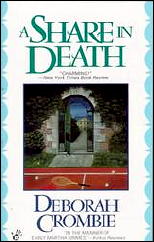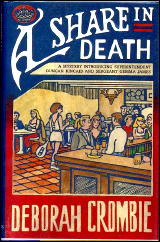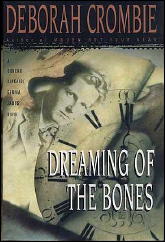Sun 31 Jul 2011
DEBORAH CROMBIE – A Share in Death. Charles Scribner’s Sons, 1993. Berkley, paperback, May 1994. Avon, pb, August 2003.

A Share in Death is the first of what is now fourteen books in author Deborah Crombie’s Duncan Kincaid & Gemma James series, both of Scotland Yard. Kincaid is a rising star in the ranks and a Detective Superintendent at the time this one takes place. We do not see much of Gemma. She’s a Sergeant newly assigned to Kincaid, and (we are told) they work as quite a team together.
But thanks to a cousin and his wife who couldn’t get away, Kincaid is off to Yorkshire at the beginning of the book, for a bit of pampering at a luxury timeshare he couldn’t begin to afford on his own, while Gemma is left to take care of loose ends back in London. And quite naturally murder soon occurs, then another, and Kincaid’s attempt at anonymity is foiled almost at once.
While of course anyone from the outside might have been the killer, the odds are highly against it. This is the present version of one of those old isolated manor house mysteries of the 30s and 40s, where the killer is one of the suspects, but which one?

The Texas-born Crombie’s forte is description, characterization and dialogue, three big pluses that not every detective story writers has a full supply of, and which has made her books quite popular, following as they do the lives of the two lead characters throughout the series, as well as the cases they work on together. (A Share in Death was nominated for the Agatha and Macavity awards for Best First Novel of 1993, and the fifth in the series, Dreaming of the Bones, was nominated for a Best Novel Edgar by the MWA for Best Novel in 1997.)
I may not visit the right websites, however, as I haven’t read a lot about her, not as much as I think I should have, considering that she writes old-fashioned detective stories combined with the “cozy†aspects that present day fans seem to demand.
Description, characterization and dialogue: all three present and accounted for. The plotting I had some problems with. Not major ones, but when a suspect and possible witness starts to tell the investigating officer something, and they’re interrupted before they can say their piece, don’t your armchair detecting organs make you sit up and take notice? Mine do, and they did.

And it’s always a problem when the concluding chapter is the weakest of the book. The clues are all there – I checked to make sure – but it’s only under the barest of possibilities that Kincaid could have made the jump in logic that he did and come up with the identity of the killer, accurately, when he did. Maybe, I grant you, but only maybe.
The next would-be victim’s behavior is even more inexplicable, especially after a previous attempt on his/her life. Hie off by yourself to an isolated spot in the local countryside? Not me, not if it were I, not one chance in a thousand, and that’s the understatement of the year.
I tell you this not to dissuade you from reading the book, far from it. There is far too much good to it for that to be my intention. It does suggest that writing a puzzle to be solved in a mystery novel is much harder than anyone who has never tried it may think. For a first novel and these exceptions, A Share in Death is awfully good.